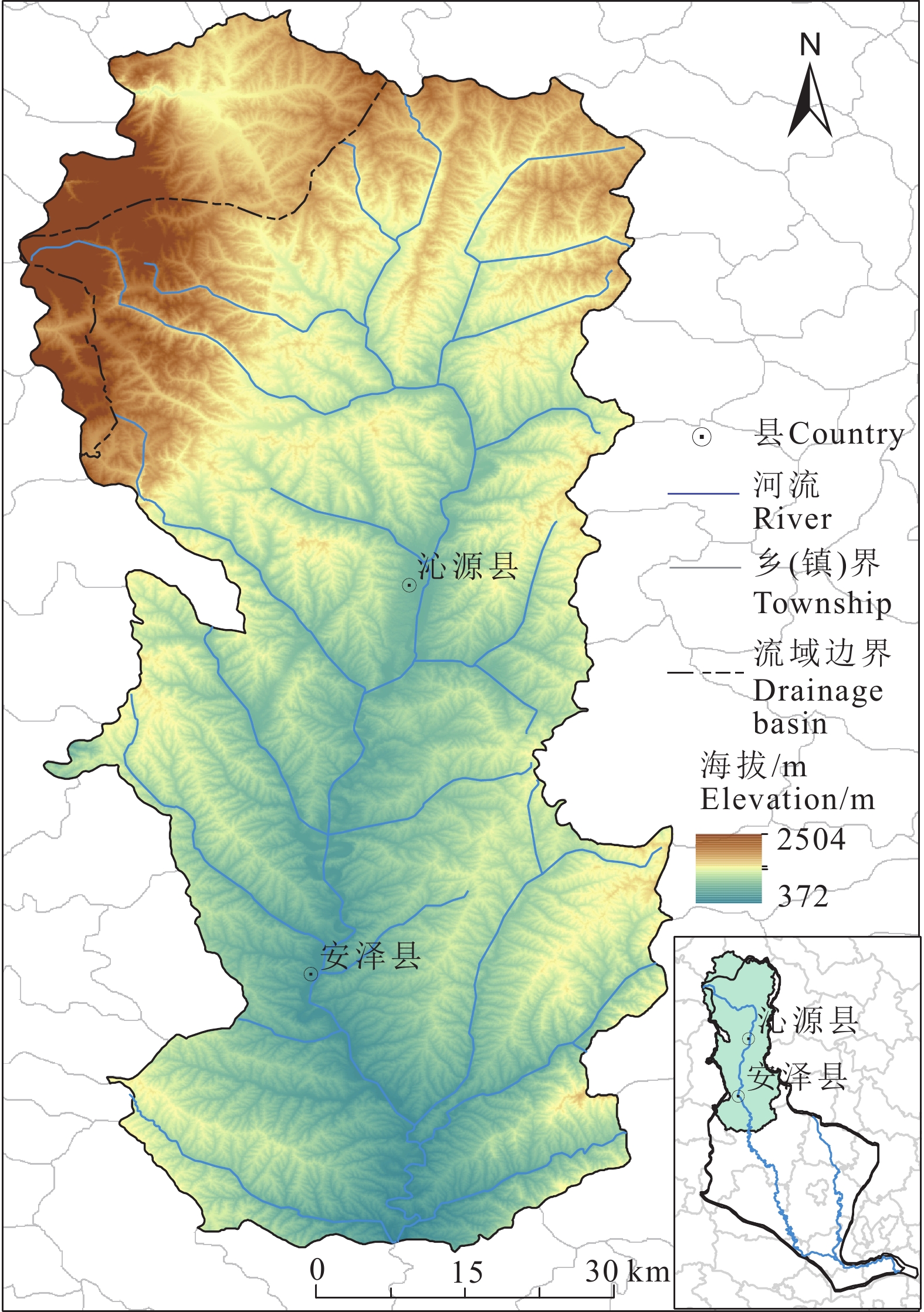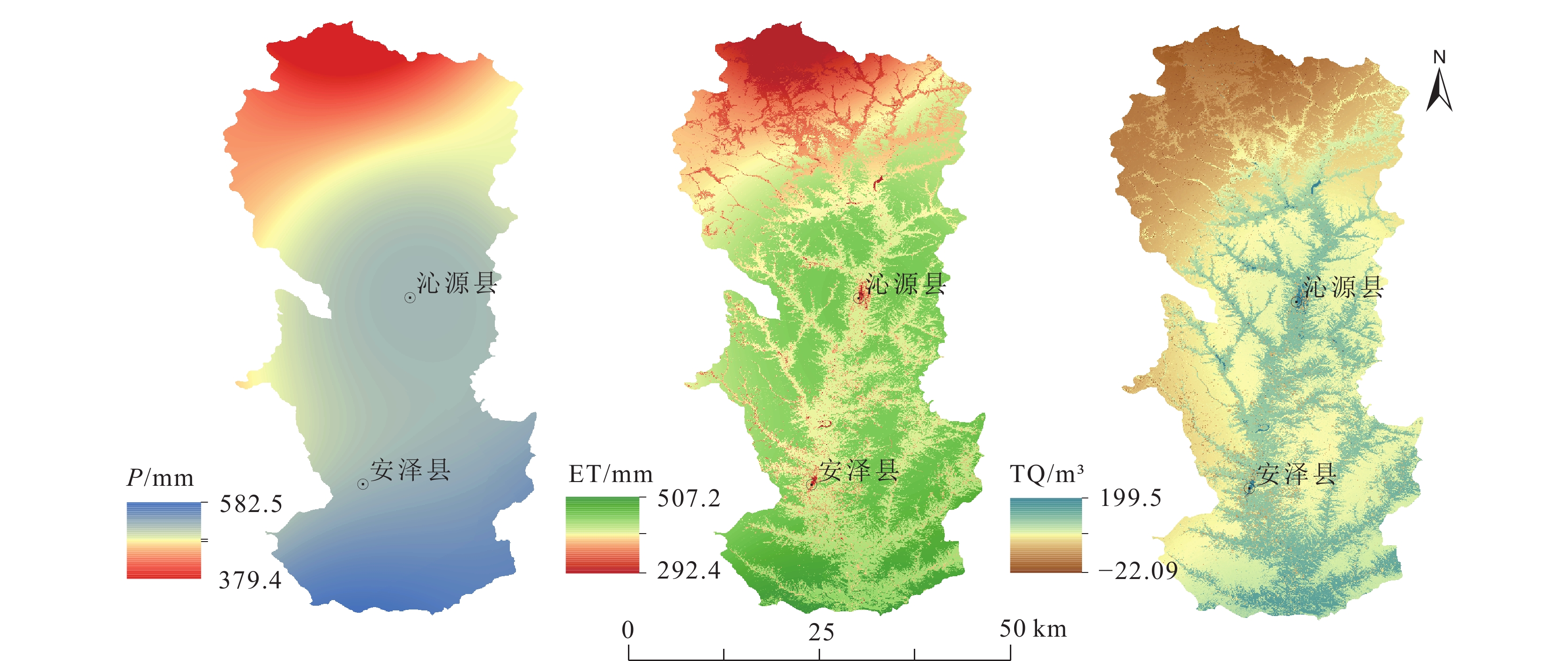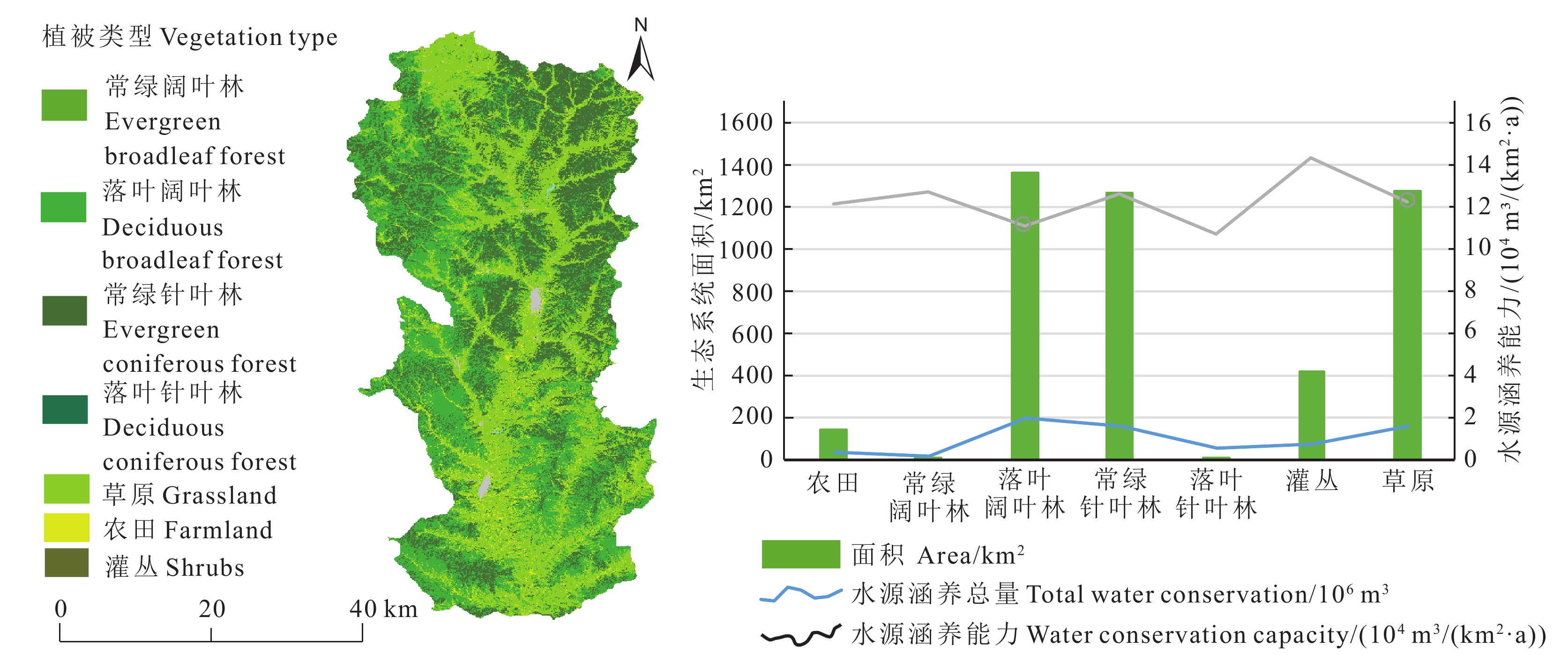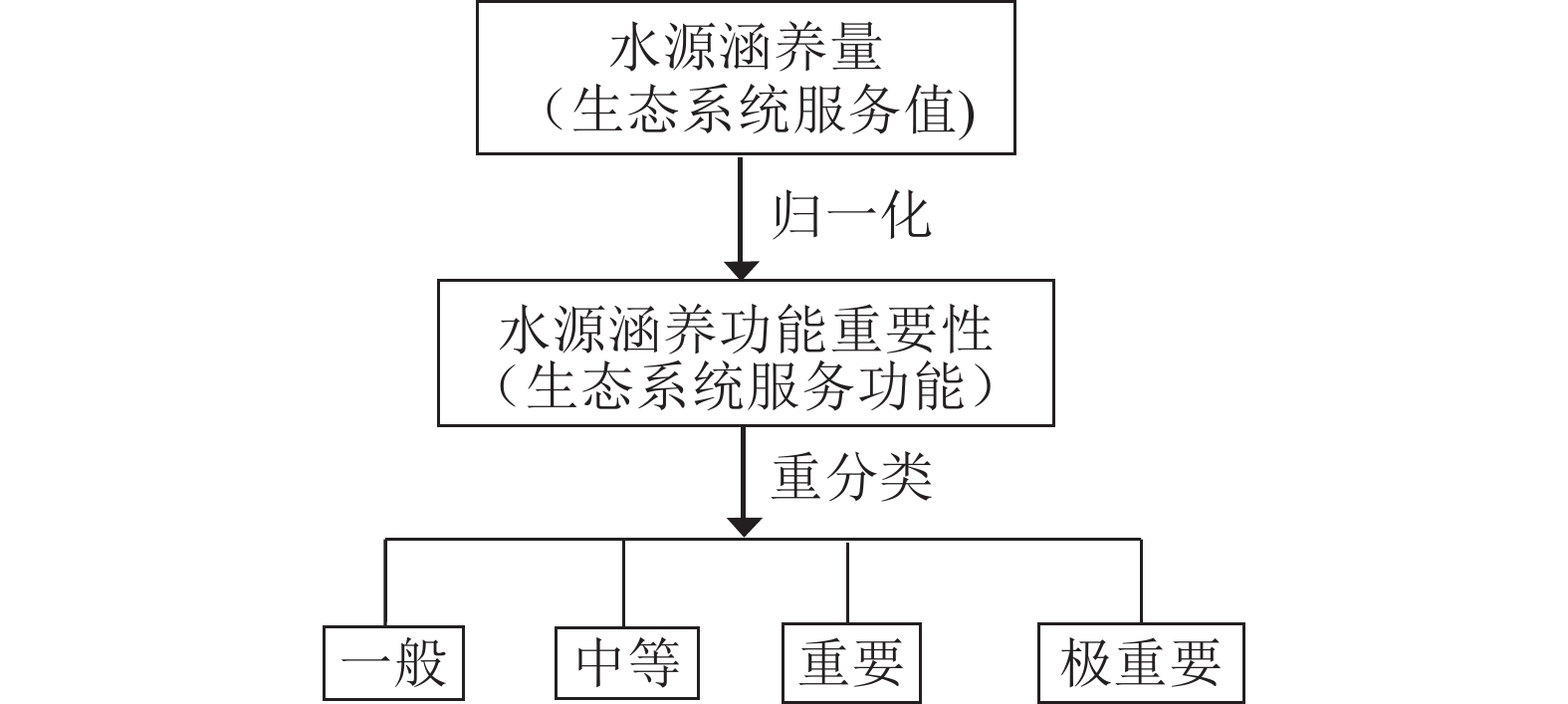Spatial pattern of water conservation function and ecological management suggestions in the catchment area of the upper reaches of Qinhe River in the Yellow River Basin from 1990 to 2020
-
摘要:
研究目的 沁河流域作为黄河中游重要的来水区与水土功能保持区,流域上游汇水区主要涵括沁源与安泽两县,科学分析其水源涵养能力的时空变化特征与影响因素可为沁河中下游地区乃至流域范围的生态环境修复与黄河流域生态保护和高质量发展规划提供技术依据。
研究方法 本文采用水量平衡方法,对1990—2020年30年间区域内生态系统水源涵养功能时空动态变化特征与不同因素对水源涵养能力的影响进行分析讨论,根据区域水源涵养能力并结合其内自然保护地分布划分出区域水源涵养重要性等级。
研究结果 (1)研究区内水源涵养能力空间上表现出南高北低,中间高,四周低,地域差异显著,多年水源涵养量均值为366.74×106 m3;近30年水源涵养功能变化趋势呈现先减少后增加的特征。(2)气候因子与水源涵养量相关性较强,植被类型也影响着水源涵养的空间特性。植被类型中,森林是区域内生态系统水源涵养的主体,但从水源涵养能力来看灌丛要高于森林和草原。(3)研究区内水源涵养重要和极重要区域总面积为733.38 km2,占研究区总面积的35%,两者水源涵养总量占全区的53.63%,主要分布在河流两岸与大起伏山地过渡的中小起伏山地之中以及安泽县的南部区域,是整个研究区的水源涵养集中地区。
结论 针对沁河流域上游水源涵养能力的建设,提出了一些生态治理措施,包括将灵空山、花坡一带确定为水源涵养功能极重要区域;因地制宜增加水源涵养能力较强的树种,加大亚高山草甸和温带草原的治理与恢复。
Abstract:This paper is the result of ecological environment geological survey engineering.
Objective The Qinhe River Basin serves as an important water−receiving area and soil−water conservation functional area in the middle reaches of the Yellow River. The main water catchment area in the upper reaches of the basin mainly covers two counties, Qinyuan and Anze. Scientific analysis of the temporal and spatial variation characteristics and influencing factors of its water conservation capacity can provide technical basis for the ecological environment restoration in the middle and lower reaches of the Qinhe River and even the entire basin, as well as for the ecological protection and high−quality development planning of the Yellow River Basin.
Methods This paper uses the water balance method to analyze and discuss the spatiotemporal dynamic change characteristics of the water conservation function of the ecosystem in the region during the 30 years from 1990 to 2020 and the influence of different factors on the water conservation capacity.According to the regional water conservation capacity and combined with the distribution of natural protected areas within it, the importance level of regional water conservation is divided.
Results (1) In terms of space, the water conservation capacity in the study area shows a pattern of being high in the south and low in the north, high in the middle and low around, with significant regional differences. The average value of multi−year water conservation volume is 366.74×106 m3.The change trend of water conservation function in nearly 30 years shows a characteristic of first decreasing and then increasing. (2) Climate factors have a strong correlation with water conservation volume, and vegetation types also affect the spatial characteristics of water conservation.Among vegetation types, forests are the main body of water conservation in the ecosystem within the region. However, in terms of water conservation capacity, shrublands are higher than forests and grasslands. (3) The total area of important and important−highly water conservation areas in the study area is 733.38 km2, accounting for 35% of the total area of the study area.The total amount of water conservation of the two accounts for 53.63% of the whole area. They are mainly distributed in the small and medium−sized undulating mountains in the transition between the two sides of the river and the large undulating mountains and the southern area of Anze County. It is the concentrated area of water conservation in the entire study area.
Conclusions For the construction of water conservation capacity in the upper reaches of the Qinhe River Basin, some ecological governance measures are proposed, including identifying the Lingkong Mountain and Huapo areas as extremely important areas for water conservation function. According to local conditions, tree species with strong water conservation capacity can be increased, and the governance and restoration of subalpine meadows and temperate grasslands can be strengthened.
-

-
表 1 平均地表径流系数
Table 1. Mean surface runoff coefficients
生态系统类型 植被类型 平均地表径流系数/% 森林 常绿阔叶林 4.7 常绿针叶林 4.5 落叶阔叶林 2.7 落叶针叶林 0.9 灌丛 常绿阔叶灌丛 4.3 落叶阔叶灌丛 4.2 草原 温带草原 3.9 高山草甸 4.2 耕地 旱地 16.3 灌溉农田 18.3 湿地 沼泽和水库 0.00 表 2 研究区水源涵养功能评价分级
Table 2. Evaluation and grading of water conservation function in the study area
水源涵养能力 一般 中等 重要 极重要 累积服务值占服务总值比例/% <15 15~35 35~50 >50 水源涵养量/(107 m3) 2.84 16.71 12.58 4.23 面积/km2 605.97 2693.15 941.81 283.52 面积占比/% 13.24 59.52 20.81 6.27 表 3 研究区自然保护区与国家公园
Table 3. Nature reserves and national parks in study areas
名称 县域 面积/km2 保护对象 类型 国家级自然保护区 灵空山 沁源 88.65 以油松为主的典型暖温带针阔叶森林生态系统体系和珍稀动物 森林生态系统 省级自然保护区 红泥寺 安泽 81.79 落叶阔叶林和针阔混交林为主的森林生态系统,野生物物种 森林生态系统 国家级森林公园 太岳山 沁源 86.65 暖温带针阔叶森林生态系统及丰富的珍稀生物物种 森林生态系统 国家级森林公园 安泽 安泽 198.24 暖温带针阔叶森林生态系统体系和丰富珍稀动物 森林生态系统 国家级森林公园 菩提山 沁源 32.08 沁河流域的水源涵养区,油松集中分布地,珍稀动物栖息地 森林生态系统 省级森林公园 红叶岭 安泽 112.43 暖温带针阔叶森林生态系统,黄栌景观区 森林生态系统 国家级草原公园 花坡 沁源 26.67 亚高山草甸,高原气候特征、生长矮草类高山植物,天然的优良牧场 草原生态系统 国家级湿地公园 沁河源 沁源 0.94 沁河源头,涵盖了河流湿地、沼泽湿地、库塘湿地三大类型 湿地生态系统 -
[1] Bai Yiru, Wang Youke, Wang Yong. 2011. Comparative study on calculation methods for reference crop evapotranspiration in hill and gully area of the loess plateau[J]. Journal of Irrigation and Drainage, 30(4): 31−34 (in Chinese with English abstract).
[2] Budyko M . 1974. Cimate and Life [M]. London: Academic Press.
[3] Cao Yelin, Song Jinxi, Li Mingyue, Wang Huiyuan. 2020. Evaluation of ecosystem water conservation function of Shaanxi Province[J]. Journal of Soil and Water Conservation, 34(4): 217−223 (in Chinese with English abstract).
[4] Chen Wenhua, Xu Juan, Li Shuangcheng. 2021. Water conservation function of mountainous city in western Yunnan: A case study of Baoshan City[J]. Acta Scientiarum Naturalium Universitatis Pekinensis, 57(6): 1153−1160 (in Chinese with English abstract).
[5] Cingolani A M, Poca M, Giorgis M A, Vaieretti M, Gurvich D, Whitworth–Hulse J, Renison D. 2015. Water provisioning services in a seasonally dry subtropical mountain: Identifying priority landscapes for conservation[J]. Journal of Hydrology, 525: 178−187. doi: 10.1016/j.jhydrol.2015.03.041
[6] Fan Yaning, Liu Kang, Chen Shanshan, YuanJiagen. 2017. Spatial pattern analysis on water conservative functionality of land ecosystem in northern slope of Qinling Mountains[J]. Bulletin of Soil and Water Conservation, 37(2): 50−56 (in Chinese with English abstract).
[7] Gong Fei, Luo Yong, Tian Xi, Yu Hui. 2020. Evaluating the importance of water conservation function in Bashang area, Zhangjiakou[J]. Pratacultural Science, 37(7): 1337−1344 (in Chinese with English abstract).
[8] Gong Shihan, Xiao Yang, Zheng Hua, Xiao Yi, Ouyang Zhiyun. 2017. Spatial patterns of ecosystem water conservation in China and its impact factors analysis[J]. Acta Ecologica Sinica, 37(7): 2455−2462 (in Chinese with English abstract).
[9] Guo Xinya, Du Shixun, Ning Ting, Li Xia, Sang Manjie, Zhang Mengying. 2018. Study on radiation benefit of water conservation function in the headstream area of the Qinhe Basin[J]. Research of Soil and Water Conservation, 25(6): 365−376 (in Chinese with English abstract).
[10] Han Shuangbao, Li Fucheng, Wang Sai, Li Haixue, Yuan Lei, Liu Jingtao, Shen Haoyong, Zhang Xueqing, Li Changqing, Wu Xi, Ma Tao, Wei Shibo, Zhao Minmin. 2021. Groundwater resource and eco–environmental problem of the Yellow River Basin[J]. Geology in China, 48(4): 1001−1019 (in Chinese with English abstract).
[11] Hou Xiaochen, Sun Wei, Li Jiangui, Li Quansheng. 2018. The progress of research and forecast on the quantification of the forest water conservation capacity[J]. Journal of Arid Land Resources and Environment, 32(1): 121−127 (in Chinese with English abstract).
[12] Hou Guangliang, Xu Changjun, Li Xiaoqin, Qi Baozheng. 2021. Spatial pattern of water conservation function in Hehuang Valley[J]. Ecological Science, 40(4): 169−176 (in Chinese with English abstract).
[13] Hoyer R, Chang H. 2014. Assessment of freshwater ecosystem services in the Tualatin and Yamhill basins under climate change and urbanization[J]. Applied Geography, 53: 402−416.
[14] Hu Chanjuan, Liu Guohua, Chen Liding, Wu Yaqiong. 2012. Vegetation and soil properties under different vegetation patterns along the slope in the hilly area of the Loess Plateau[J]. Arid Land Geography, 35(5): 787−794 (in Chinese with English abstract).
[15] Jia Huimin, Hu Qiujia, Zhang Cong, Zhang Jianguo, Zhang Wensheng, Wu Dingquan, Liu Chunchun, Ma Hui, Zhang Wuchang. 2024. Industrial gas flow obtained from the trial production of No.4 thin coal seam in southern QinshuiBasin, Shanxi Province[J]. Geology in China, 51(4): 1447−1448 (in Chinese).
[16] Lü Aili, Huo Zhiguo, Yang Jianying. 2020. Phenological characteristics of representative woody plants at different altitude sites in Jinnan Region and their response to climate change[J]. Chinese Journal of Agrometeorology, 41(2): 65−75 (in Chinese with English abstract).
[17] Li Haoyang. 2021. Research on water conservation function of Xiaoxing'an Mountains based on GIS[J]. Territory & Natural Resources Study, (2): 50−54 (in Chinese with English abstract) .
[18] Li Jing, Ren Zhiyuan. 2018. Spatiotemporal change of water conservation value of Loess Plateau ecosystem in northern Shaanxi Province[J]. Chinese Journal of Ecology, 27(2): 240−244 (in Chinese with English abstract).
[19] Li Meng, Wang Chuansheng, Zhang Xuefei. 2019. Identification of the candidate areas of ecological protection red lines based on water conservation function in territory spatial planning[J]. Geographical Research, 38(10): 2447−2457 (in Chinese with English abstract).
[20] Li Yanli. 2014. A brief discussion on the burial and development of coal resources in coal mining enterprises in Qinyuan County[J]. Huabei Land and Resources, (4): 103−105 (in Chinese).
[21] Nie Yihuang, Gong Bing, Li Zhong. 2010. The spatial–temporal variations of water conservation capacity in Qinghai–Tibet Plateau[J]. Library and Information Service, 17(1): 373−377 (in Chinese with English abstract).
[22] Pessacg N, Flaherty S, Brandizi L, Solman S, Pascual M. 2015. Getting water right: A case study in water yield modelling based on precipitation data[J]. Science of the Total Environment, 537: 225−234.
[23] Qiu Wei, Fan Qingxin, Wang Mingxuan, Han Wentao, Peng Xuexuan. 2014. Amending the hargreaves model based on ecological water[J]. Journal of Harbin Institute of Technology, 46(2): 21−25 (in Chinese with English abstract).
[24] Sun Qinglin, Li Yansen, Guo Jikai, Wu Xiuqin. 2015. Assessment of water conservation function of forest ecosystem in Yunhe County, Zhejiang Province[J]. Acta Scientiarum Naturalium Universitatis Pekinensis, 51(5): 888−896.
[25] Sun Yijie, Ren Zhiyuan, Zhao Shengnan. 2016. Spatial–temporal difference analysis of ecosystem service trade–off and synergy in the Guanzhong Basin of China[J]. Resources Science, 38(11): 2127−2136 (in Chinese with English abstract).
[26] Sun Zhangtao, Yu Zhengwei, Shu Siqi, Xu Chuangsheng, Shu Yang. 2023. Evaluation of ecosystem services of Chinese provincial land and suggestions for ecological geological survey[J]. Geology in China, 50(2): 479−494 (in Chinese with English abstract).
[27] Wang Baosheng, Chen Huaxiang, Dong Zheng, Zhu Wei, Qiu Quanyi. 2020. Impact of land use change on the water conservation service of ecosystems in the urban agglomeration of the Golden Triangle of Southern Fujian, China, in 2030[J]. Acta Ecologica Sinica, 40(2): 484−498 (in Chinese with English abstract).
[28] Wang Guoqing. 2022. Definition of water conservation areas in the Yellow River Basin[J]. Journal of China Hydrology, 42(2): 65 (in Chinese).
[29] Wang Yao, Chen Ruishan, Guo Chihui, Xia Zilong. 2021. Changes of resource and environmental pattern of the Yellow River Basin in the past 40 years and suggestions on geological work[J]. Geology in China, 48(1): 1−20 (in Chinese with English abstract).
[30] Wang Yihao, Li Hongmei. 2019. Climate analysis of Qinyuan County and its impact on agricultural production[J]. Nongcun Shiyong Jishu, (8): 116 (in Chinese).
[31] Wang Youqi, Bai Yiru, Zhan Xiuli. 2013. Application and modification of hargreaves models on the loess plateau[J]. Journal of Irrigation and Drainage, 32(1): 36−38 (in Chinese with English abstract).
[32] Xiao Jianshe, Qiao Bin, Chen Guoqian, Shi Feifei, Cao Xiaoyun, Zhu Cunxiong. 2020. Land use change and evolution of ecosystem service value in Maduo County of source region of the Yellow River[J]. Acta Ecologica Sinica, 40(2): 510−521 (in Chinese with English abstract).
[33] Yang Liangchen, Zhang Jianqiang, Yang Xinbing, Ding Jie. 2019. Water consumption analysis on seven dominant arbor tree species in earth and rock mountains in northern China[J]. Journal of Central South University of Forestry & Technology, 39(3): 69−75 (in Chinese with English abstract).
[34] Zhang L, Potter N, Hickel K, Yongqiang Z, Quanxi S. 2008. Water balance modeling over variable time scales based on the Budykoframework–Model development and testing[J]. Journal of Hydrology, 360(1−4): 117−131.
[35] Zhang L, Dawes W R, Walke G R. 2001. Response of mean annual evapotranspiration to vegetation changes at catchment scale[J]. Water Resources Research, 37(3): 701−708. doi: 10.1029/2000WR900325
[36] Zhang Junyu, Cheng Jinhua, Zhang Hongjiang, Zhou Zefu, Zhang Youyan, Lu Xiaoyu, Ma Xijun, Li Guohui. 2012. Reserves and water capacity characteristics of three kinds of litter in loess hilly region of West Shanxi Province[J]. Journal of Northwest A & F University (Natural Science Edition), 40(10): 69−74, 81 (in Chinese with English abstract).
[37] Zhang Benxing, PanYun, Li Xiaojuan. 2012. Revision coefficient of hargreaves model and its values in different climatic regions of China[J]. Geography and Geo–Information Science, 28(1): 51−54,113 (in Chinese with English abstract).
[38] Zhang Biao, Wang Shuang, Li Qingxu, Xie Gaodi. 2021. Spatio–temporal changes of water conservation service in the Beijing–Tianjin sandstorm source control project area[J]. Acta Ecologica Sinica, 41(19): 7530−7541 (in Chinese with English abstract).
[39] Zhang Dan, Liang Kang, Nie Rong, Gu Renying. 2016. Estimation of evapotranspiration and sensitivity to climate and the underlying surface based on the Budyko Framework[J]. Resources Science, 38(6): 1140−1148 (in Chinese with English abstract).
[40] Zhao Huanyin, Zhu Jinwei, Wang Weihua. 1994. Study of runoff in forest belts and pastures[J]. Journal of Soil and Water Conservation, 8(2): 56−61 (in Chinese with English abstract).
[41] Zhuo Jing, He Huijuan, Zou Jiye. 2017. Characteristics of water conservation in Qinling forest area in recent 15 a[J]. Library and Information Service, 34(3): 604−612 (in Chinese with English abstract).
[42] Zuo Qiting, Wang Jiaoyang, Yang Feng, Song Quanxiang. 2022. Concept analysis of water conservation and calculation methods of water conservation capacity[J]. Advances in Science and Technology of Water Resources, 42(2): 13−19 (in Chinese with English abstract).
[43] 白一茹, 汪有科, 汪勇. 2011. 黄土高原丘陵沟壑区多种参考作物需水量模型对比分析[J]. 灌溉排水学报, 30(4): 31−34.
[44] 曹叶琳, 宋进喜, 李明月, 王辉源. 2020. 陕西省生态系统水源涵养功能评估分析[J]. 水土保持学报, 34(4): 217−223.
[45] 陈文华, 徐娟, 李双成. 2021. 滇西山地城市水源涵养功能研究–以保山市为例[J]. 北京大学学报(自然科学版), 57(6): 1153−1160.
[46] 范亚宁, 刘康, 陈姗姗, 袁家根. 2017. 秦岭北麓陆地生态系统水源涵养功能的空间格局[J]. 水土保持通报, 37(2): 50−56.
[47] 巩飞, 罗勇, 田犀, 于慧. 2020. 张家口坝上地区水源涵养功能的重要性评估[J]. 草业科学, 37(7): 1337−1344. doi: 10.11829/j.issn.1001-0629.2020-0094
[48] 龚诗涵, 肖洋, 郑华, 肖燚, 欧阳志云. 2017. 中国生态系统水源涵养空间特征及其影响因素[J]. 生态学报, 37(7): 2455−2462.
[49] 郭新亚, 杜世勋, 宁婷, 李霞, 桑满杰, 张梦莹. 2018. 沁河源区水源涵养功能辐射效益研究[J]. 水土保持研究, 25(6): 365−376.
[50] 韩双宝, 李甫成, 王赛, 李海学, 袁磊, 刘景涛, 申豪勇, 张学庆, 李长青, 吴玺, 马涛, 魏世博, 赵敏敏. 2021. 黄河流域地下水资源状况及其生态环境问题[J]. 中国地质, 48(4): 1001−1019.
[51] 侯晓臣, 孙伟, 李建贵, 李全胜. 2018. 森林生态系统水源涵养能力计量方法研究进展与展望[J]. 干旱区资源与环境, 32(1): 121–127.
[52] 侯光良, 许长军, 李晓勤, 戚宝正. 2021. 河湟谷地水源涵养功能空间格局研究[J]. 生态科学, 40(4): 169−176.
[53] 胡婵娟, 刘国华, 陈利顶, 吴雅琼. 2012. 黄土丘陵区坡面尺度上不同植被格局下植物群落和土壤性质研究[J]. 干旱区地理, 35(5): 787−794.
[54] 贾慧敏, 胡秋嘉, 张聪, 张建国, 张文胜, 吴定泉, 刘春春, 马辉, 张武昌. 2024. 山西省沁水盆地南部4#煤薄煤层试采获得煤层气工业气流[J]. 中国地质, 51(4): 1447−1448.
[55] 吕爱丽, 霍治国, 杨建莹. 2020. 晋南地区不同海拔高度典型木本植物物候特征及其对气候变化的响应[J]. 中国农业气象, 41(2): 65−75. doi: 10.3969/j.issn.1000-6362.2020.02.001
[56] 李浩洋. 2021. 基于GIS的小兴安岭地区水源涵养功能研究[J]. 国土与自然资源研究, (2): 50−54.
[57] 李晶, 任志远. 2008. 陕北黄土高原生态系统涵养水源价值的时空变化[J]. 生态学杂志, 27(2): 240−244.
[58] 李萌, 王传胜, 张雪飞. 2019. 国土空间规划中水源涵养功能生态保护红线备选区的识别[J]. 地理研究, 38(10): 2447−2457. doi: 10.11821/dlyj020180011
[59] 李艳丽. 2014. 浅谈沁源县煤矿企业煤炭资源的埋藏与开发[J]. 华北国土资源, (4): 103−105. doi: 10.3969/j.issn.1672-7487.2014.04.070
[60] 聂忆黄, 龚斌, 李忠. 2010. 青藏高原水源涵养能力时空变化规律[J]. 地学前缘, 17(1): 373−377.
[61] 邱微, 樊庆锌, 王明轩, 韩文滔, 彭雪璇. 2014. 基于生态用水的HARGREAVES模型修正[J]. 哈尔滨工业大学学报, 46(2): 21−25.
[62] 孙清琳, 李延森, 郭继凯, 吴秀芹. 2015. 云和县森林生态系统水源涵养功能评估. 北京大学学报(自然科学版), 51(5): 888–896.
[63] 孙艺杰, 任志远, 赵胜男. 2016. 关中盆地生态服务权衡与协同时空差异[J]. 资源科学, 38(11): 2127−2136.
[64] 孙张涛, 余正伟, 舒思齐, 许闯胜, 舒阳. 2023. 中国省域生态系统服务价值评价与生态地质调查工作建议[J]. 中国地质, 50(2): 479−494 doi: 10.12029/gc20221027001
[65] 王保盛, 陈华香, 董政, 祝薇, 邱全毅, 唐立娜. 2020. 2030年闽三角城市群土地利用变化对生态系统水源涵养服务的影响[J]. 生态学报, 40(2): 484−498.
[66] 王国庆. 2022. 黄河流域水源涵养区界定[J]. 水文, 42(2): 65. doi: 10.3969/j.issn.1000-0852.2022.2.sw202202012
[67] 王尧, 陈睿山, 郭迟辉, 夏子龙. 2021. 近40年黄河流域资源环境格局变化分析与地质工作建议[J]. 中国地质, 48(1): 1−20. doi: 10.12029/gc20210101
[68] 王一豪, 李红梅. 2019. 沁源县气候分析及对农业生产的影响[J]. 农村实用技术, (8): 116.
[69] 王幼奇, 白一茹, 展秀丽. 2013. Hargreaves模型在黄土高原地区的应用与改进[J]. 灌溉排水学报, 32(1): 36−38.
[70] 肖建设, 乔斌, 陈国茜, 史飞飞, 曹晓云, 祝存兄. 2020. 黄河源区玛多县土地利用和生态系统服务价值的演变[J]. 生态学报, 40(2): 510−521.
[71] 杨良辰, 张健强, 杨新兵, 丁杰. 2019. 华北土石山区7种优势乔木树种耗水分析[J]. 中南林业科技大学学报, 39(3): 69−75.
[72] 张君玉, 程金花, 张洪江, 周泽福, 张友焱, 陆晓宇, 马西军, 李国会. 2012. 晋西黄土丘陵区3个树种人工林枯落物的持水特性[J]. 西北农林科技大学学报(自然科学版), 40(10): 69−74, 81.
[73] 张本兴, 潘云, 李小娟. 2012. 中国不同气候区域Hargreaves模型的修正[J]. 地理与地理信息科学, 28(1): 51−54,113.
[74] 张彪, 王爽, 李庆旭, 谢高地. 2021. 京津风沙源治理工程区水源涵养功能时空变化分析[J]. 生态学报, 41(19): 7530–7541.
[75] 张丹, 梁康, 聂茸, 顾人颖. 2016. 基于Budyko假设的流域蒸散发估算及其对气候与下垫面的敏感性分析[J]. 资源科学, 38(6): 1140−1148.
[76] 赵焕胤, 朱劲伟, 王维华. 1994. 林带和牧草地径流的研究[J]. 水土保持学报, 8(2): 56−61. doi: 10.3321/j.issn:1009-2242.1994.02.013
[77] 卓静, 何慧娟, 邹继业. 2017. 近15 a秦岭林区水源涵养量变化特征[J]. 干旱区研究, 34(3): 604−612.
[78] 左其亭, 王娇阳, 杨峰, 宋全香. 2022. 水源涵养相关概念辨析及水源涵养能力计算方法[J]. 水利水电科技进展, 42(2): 13−19.
-




 下载:
下载:





